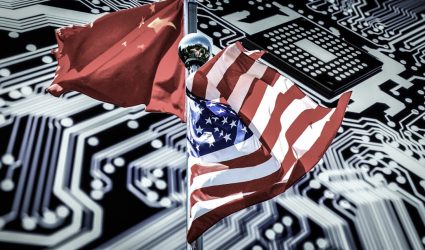China Focuses on Building Its Own Core Tech as U.S. Curbs Supply

(Bloomberg) – China said it needs to build its own core technology because it can’t rely on buying it from elsewhere, as the Communist Party laid out plans for greater economic self-sufficiency.
Outlining details of its new five-year economic plan that elevates self-reliance in technology and innovation, senior party officials said Friday the nation would accelerate development of the kind of technology needed to spur the next stage of economic development. Key to that are bold measures to cut reliance on foreign know-how, although that doesn’t mean China will cut itself off from the world.
“To achieve technological advancement, China increasingly needs the world, and the world increasingly needs China,” Wang Zhigang, science and technology minister, told a briefing in Beijing Friday. The nation planned to “improve our ability to make innovations independently and do our own things well because we cannot ask for or buy the core technologies from elsewhere.”
At the same time, “we hope to learn from advanced international experience, and will share more Chinese technological outcomes with the world,” he said.
Tech stocks were some of Friday’s best-performers. Semiconductor Manufacturing International Corp., the country’s largest chipmaker, surged as much as 8% in Hong Kong in its biggest intraday gain in about two weeks. On mainland bourses, Gigadevice Semiconductor Beijing Inc. climbed its 10% limit, becoming the biggest gainer on the CSI 300 index as of early afternoon.
Beijing’s drive for tech self-sufficiency is gaining urgency as the U.S. seeks to contain the rise of its geopolitical rival. The U.S. has pressured allies to shun equipment from Huawei Technologies Co., barred dozens of China’s largest tech companies from buying American parts, and even slapped bans on ByteDance Ltd.’s TikTok and Tencent Holdings Ltd.’s WeChat.
However, officials talked down prospects of a decoupling between the world’s two largest economies and said China’s door would remain open for foreign competition.
“Complete decoupling is not realistic. And it is not good for China, the United States and the whole world,” a Communist Party Central Committee official Han Wenxiu said at the briefing. “The truth is very few would really want to see the two countries decouple. Most would want our two countries to cooperate and work together.”
The Central Committee released initial details of the five-year plan Thursday, stressing the need for sustainable growth and also pledging to develop a robust domestic market. Officials didn’t specify the pace of growth they would seek over the period, but said the National Development and Reform Commission would work on guidelines to be submitted to country’s parliament in March.
“Based on the general direction and strategy determined in the proposal, we will put forward corresponding numeric targets and specific indicators after careful estimate and calculation, so as to promote the reasonable economic growth and the steady improvement of its quality,” Ning Jizhe, vice chairman of NDRC, said at the briefing Friday.
Wang, the technology minister, said it was a strategic choice to elevate the role of innovation and make technological self-reliance a strategic pillar of national development in the plan. Han separately stated there are “three priorities of paramount importance. They are: reform, opening up and innovation.”
Central to that endeavor is self-reliance in chips, the building blocks for innovations from artificial intelligence to fifth-generation networking and autonomous vehicles.
The government now intends to confer the same priority on semiconductor development that it accorded to building its atomic capability, people with knowledge of the matter have said. That’s said to include broad support for so-called third-generation semiconductors — a nascent field in which no nation yet claims dominance — for the period through 2025.
But it will take years for local companies to match foreign counterparts in both basic manufacturing and design expertise, while there’s no ready answer to the dominance of Japanese and American names in chip-making equipment.
China imports more than $300 billion worth of integrated circuits each year and its semiconductor developers rely on U.S.-made chip design tools and patents, as well as critical manufacturing technologies from U.S. allies. Deteriorating ties between Beijing and Washington have made it increasingly difficult for Chinese companies to source components and chip-making technologies from overseas.

